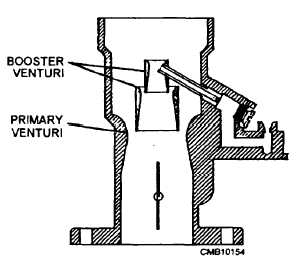Home > Construction Training Manuals > Construction Mechanic Basic > Figure 4-26.Mechanically Operated Metering Rod.
provides the leanest, most fuel efficient air-fuel ratio. It functions from about 20 to 55 mph or 2,000 to 3,000 rpm.
The high-speed system is the simplest system. It consists of the high-speed jet, the main discharge passage, the emulsion tube, the air bleed, and the venturi.
The HIGH-SPEED JET is a fitting with a precision hole drilled into the center. This fitting screws into a threaded hole in the fuel bowl. One jet is used for each air horn. The hole size determines how much fuel flows through the system. A number is stamped on the high-speed jet to denote the diameter of the hole. Since jet numbering systems vary, refer to the manufacturer's manual for information on jet size.
The EMULSION TUBE and AIR BLEED add air to the fuel flowing through the main discharge tube. The premixing of air with fuel helps the fuel atomize, as it is discharged into the air horn.
The VENTURI is the hourglass shape, formed in the side of the carburetor air horn. One or two booster venturis (fig. 4-25) can be added inside the primary venturi to increase vacuum at lower engine speeds.

Figure 4-25. - Booster venturi
The basic operation of the high-speed system is as follows:
When the engine speed is high enough, air flow through the carburetor forms a high vacuum in the venturi. The vacuum pulls fuel through the main metering system.

Figure 4-26. - Mechanically operated metering rod.
Continue Reading